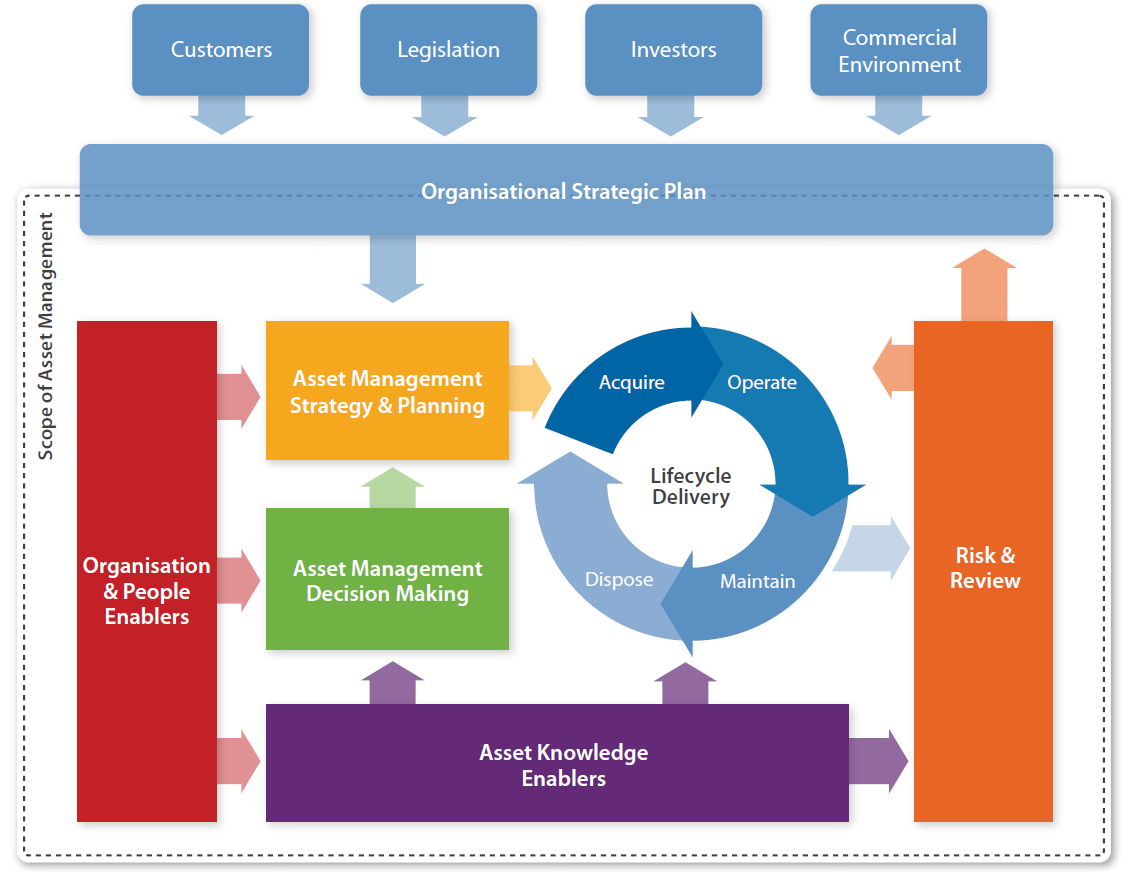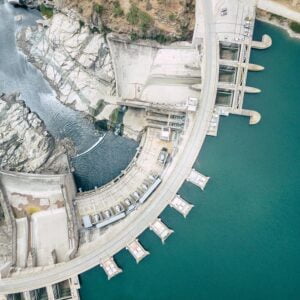Our series has already explored strategic asset management planning, the asset management planning and decision making process and integrating and aligning foundation documents in previous parts. These are obviously key processes for successful asset management, but it is equally obviously insufficient as the actions identified in the plan(s) will need to draw on other organisational processes.
This is the eighth in a series of 12 articles on Implementing ISO 55000.
Articles in this series
The requirement is laid out in clause 8.1 of ISO 55001:2014:
“The organisation shall plan, implement and control the processes needed to meet requirements…”
The clause goes on to identify, implement and monitor the processes and treat/monitor risks, but it does not dictate specific processes. ISO 55002 does not provide much additional guidance, so we turn to the Institute of Asset Management’s (IAM’s) Conceptual Asset Management Model:

This model shows very general process requirements, including the planning and decision making processes we already discussed, as well as processes for life cycle delivery, asset information management, organisation and people management, risk management and performance management/review and these will apply to all organisations. Unfortunately, the details of these processes depend on the nature of the organisation and its assets, so there is no “one-size fits all” set of processes. For example, an organisation that builds civil assets from raw materials will need quite different acquisition processes to an organisation that buys and operates vehicles from the manufacturer. This means your organisation is going to have to do some work to identify what processes it needs and how sophisticated they need to be. Luckily, there is a global consensus to start from – the Asset Management Landscape.
The asset management landscape
The Asset Management Landscape is published by the Global Forum on Maintenance and Asset Management (GFMAM) and is currently in its second edition. It divides the discipline up into 39 subjects and 6 groups as shown below:
Strategy & planning
- Asset management policy
- Demand analysis
- Strategic planning
- Asset management planning
Organisation & people
- Procurement & supply chain management
- Asset management leadership
- Organisational structure
- Organisational culture
- Competence management
Asset information
- Asset information strategy
- Asset information standards
- Asset information systems
- Data & information management
Decision making
- Capital investment decision making
- Operations & maintenance decision making
- Lifecycle value realisation
- Resourcing strategy
- Shutdown/outage strategy
Organisation & people
- Technical standards
- Asset creation/acquisition
- Systems engineering
- Configuration management
- Maintenance delivery
- Reliability engineering
- Asset operations
- Resource management
- Shutdown/outage management
- Fault & incident response
- Asset disposal
Risk & review
- Risk management
- Contingency planning
- Sustainable development
- Management of change
- Asset health monitoring
- Asset management system monitoring
- Management reivew
- Asset costing & valuation
- Stakeholder engagement
The colour coding on these categories aligns with the IAM conceptual model above, helping you get an idea of where each subject fits. There are also good references around to help you understand the content of each subject, including the Institute of Asset Management’s Asset Management – An Anatomy, the Asset Management Council’s Asset Management Body of Knowledge and the Institute of Public Works Engineering Australia’s International Infrastructure Management Manual.
Once you’ve got an understanding of each subject, you will be in a good position to identify the processes your organisation requires. ISO 55001:2014 links these requirements to the actions identified during planning
- An organisation that undertakes complex procurements (e.g. construction of buildings or integration of complex systems) would require robust project management processes based on a suitable standard methodology(e.g. Project Management Body of Knowledge). Conversely, an organisation that buys assets “off the shelf” may have simple procurement processes focussed on achieving value for money and compliance with specifications/standards.
- An organisation that operates passenger vehicles (aviation, marine, rail, etc) would require robust operational procedures to ensure the competence of its operators and subsequent safety of its customers. Conversely, organisations that primarily own and manage roads or other fixed assets may have essentially no operational procedures since the assets are not “operated” in the usual sense.
- An organisation that employs large numbers of operators or technicians would require robust human resources processes to ensure the personnel are competent and the workforce size is appropriate. Conversely, a smaller organisation may have simple processes in this area.
In many cases, the required processes can even vary within the organisation. For example, an airline might apply strict processes to the maintenance of its aircraft but much simpler processes for the maintenance of its office facilities. These distinctions are driven by the different risk profiles of the two asset types and highlight the fundamental importance of risk in determining the processes required in an organisation. It is worth spending some time discussing this process.
Risk management processes
Every organisation considering implementing ISO 55000 needs to have a clear process for identifying and managing risks. Typically, this process is built around ISO 31000:2009 – Risk Management – Principles and Guidelines and is absolutely key to successful asset management. Every asset management decision, including selection of processes, needs to balance the competing factors of performance, cost and risk and processes must exist to identify and quantify risks in order to include them in this trade off.
It is important to note that there is no need – nor is it desirable – to maintain a separate risk management process to support asset management. The organisation’s risk appetite and identification, analysis and treatment tools should be consistent across the organisation and every decision it makes, including non-asset decisions. This has the added benefit of reducing the amount of process documentation that must be developed and maintained, with follow on reductions in areas such as training.
Process documentation
ISO 55000 draws a distinction between process and procedure that is important. Under clause 7.6.1, ISO 55001 requires an organisation’s asset management system to include:
“Documented information determined by the organisation as being necessary for the effectiveness of the asset management system”
The notes following this clause state that the extent of documentation will vary with, amongst other things, the complexity of processes. The message is clear. ISO 55000 requires organisations to think about risk associated with its processes and to document only those processes where failure to do so would threaten the effectiveness of the asset management system.
With this clause in mind and a view to reducing the administrative burden associated with implementing ISO 55000, we recommend the following principles be applied when identifying necessary procedures:
- Don’t write unnecessary documents – As we discussed above, the requirements for documented information within ISO 55001:2014 are not as onerous as you might think. This is a deliberate strategy, since many organisations excel at burying themselves in written procedures that nobody has time to read anyway.
- Second hand can be just fine – Following on from the previous point, your first preference when you do need a document should be to modify something that already exists. This is usually quicker, reduces the total number of documents and gets better buy in. It is, however, good practice to maintain a cross-reference matrix that shows how each of the requirements in ISO 55001:2014 is met within your structure.
- Keep it Simple, Sunshine – At all times keep written procedures as short and simple as possible – swim lane flowcharts and RACI (responsible, accountable, consulted, informed) charts are a good way to show people their responsibilities without telling them how to execute those responsibilities. That’s the job of training.
Conclusion
Once again, the message from ISO 55000 is clear. Organisations seeking to implement it need to spend some time contemplating their requirements before putting finger to keyboard to write new procedures. Required processes will be defined by the needs of the organisation and the required procedures will be defined by the risk implicit in failure of those processes. As such, the only truly mandatory processes within an asset management organisation are the planning process and the risk process. All other process requirements will derive from these two, although assistance and guidance can be obtained by consulting the Asset Management Landscape.
Good luck and happy process creation! If you believe you need assistance to design or enhance your processes to promote better asset management, we would be delighted to hear from you. Click here to request an obligation-free consultation with me or one of our other experienced consultants.
Looking for further training in ISO 55001 certification?
We offer a range of asset management courses, some of which specialise in ISO 55001 deliverables. If you are interested in reading more about our courses, you can do so by following the links below.
-
Product on sale
 Implementing an ISO 55001 Compliant Asset Management SystemOriginal price was: $2,275.00.$2,047.50Current price is: $2,047.50.
Implementing an ISO 55001 Compliant Asset Management SystemOriginal price was: $2,275.00.$2,047.50Current price is: $2,047.50. -
Product on sale
 Asset Management Foundation AwardOriginal price was: $1,195.00.$1,075.50Current price is: $1,075.50.
Asset Management Foundation AwardOriginal price was: $1,195.00.$1,075.50Current price is: $1,075.50.
[2] ISO 55001, p.8


